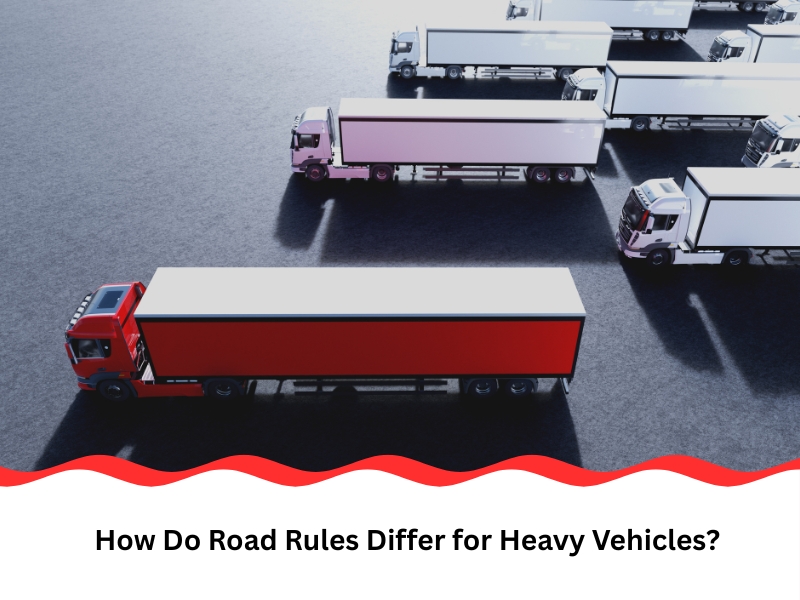Navigating the roads as a truck driver can be tricky, especially given the unique road rules for heavy vehicles. While many road rules apply to all drivers, heavy vehicle drivers face specific regulations that ensure their safety and the safety of others on the road. Understanding these differences is crucial, not only for truck drivers but also for anyone sharing the road with large vehicles. This article delves into how road rules differ for heavy vehicles and why it matters for all road users.
What are heavy vehicle road rules?
Heavy vehicle road rules govern the operation of trucks and other large vehicles on Australian roads. These rules specifically aim to reduce accidents, protect drivers, and ultimately ensure the safe operation of heavy vehicles.
- Speed limits: Heavy vehicles often have lower speed limits, especially on certain roads. This helps reduce the risk of accidents caused by their weight and momentum.
- Weight limits: The maximum weight a heavy vehicle can carry is restricted. This prevents overloading, which can damage roads and increase the likelihood of accidents.
- Use of lanes: Heavy vehicles must often stay in the leftmost highway lanes and may not be allowed to pass in certain areas.
- Truck routes: Specific routes are designated for heavy vehicles to keep them off roads unsuitable for large trucks.
- Overtaking restrictions: In certain areas, heavy vehicles are not permitted to overtake other vehicles, especially in regions with limited visibility.
These rules are vital for the safe operation of trucks and help ensure the smooth traffic flow.
Which vehicles are considered heavy vehicles under Australian law?
Under Australian law, a heavy vehicle is any vehicle that exceeds a certain weight or size limit. These regulations ensure that these vehicles don’t harm other road users or the infrastructure.
- Gross Vehicle Mass (GVM): Vehicles with a GVM greater than 4.5 tonnes are considered heavy vehicles.
- Heavy rigid vehicles: These vehicles, such as large trucks and buses, have a GVM greater than 8 tonnes.
- Combination vehicles: This includes vehicles that tow a trailer, such as semi-trailers and road trains, with a combined weight exceeding 9 tonnes.
- Buses: Public transport buses are considered heavy vehicles if they exceed 4.5 tonnes.
- Specialty vehicles: Vehicles like cranes or earth-moving equipment, which are not used for regular transportation, are classified as heavy vehicles.
Understanding what qualifies as a heavy vehicle is crucial for drivers to adhere to the correct regulations and licensing requirements.
Why do heavy vehicles have different road rules?
The road rules for heavy vehicles differ because of their unique challenges, including their size, weight, and long stopping distances. Heavy vehicle road rules are designed to address the increased risks trucks and other large vehicles pose to themselves and others on the road.
Reason | Challenge | Impact |
Stopping distances | Longer distances | Requires greater space |
Maneuverability | Difficulty in turns | Prevents accidents |
Impact on infrastructure | Road wear and tear | Limits travel locations |
Danger to smaller vehicles | Increased risk | Reduces accidents |
If you operate a heavy vehicle, it’s also essential to pay attention to maintenance issues, such as windshield cracks that require a complete replacement, as damage can impact both compliance and safety on the road.
Which rules are most commonly broken?
Heavy vehicles are subject to various rules, but drivers often break some more frequently due to the nature of the job or oversight. Drivers may inadvertently or intentionally ignore these rules, leading to severe consequences.
- Speeding: Many heavy vehicle drivers are caught speeding, especially on highways with high temptation to drive faster.
- Overloading is a common violation where trucks carry loads heavier than the legal limit, leading to fines and road damage.
- Inappropriate lane usage: Some drivers may not follow lane restrictions, especially when overtaking or driving in non-designated lanes.
- Ignoring truck routes: Not using designated routes can result in heavy vehicles navigating roads unsuitable for their size and weight.
- Fatigue driving: Driver fatigue is a critical issue. Heavy vehicle drivers sometimes push beyond regulated rest periods to meet deadlines, putting themselves and others at risk.

Awareness of these common violations can help drivers stay compliant and avoid serious consequences.
What are the penalties for breaking heavy vehicle road rules?
Breaking road rules designed for heavy vehicles can result in serious penalties, including fines, license suspensions, and even imprisonment in extreme cases. These penalties are intended to maintain road safety and discourage dangerous driving practices.
- Fines: Depending on the offence, heavy vehicle violations can result in fines of hundreds to thousands of dollars.
- License suspension: In some cases, drivers face suspension and disqualification of driver licences for serious violations, such as speeding or driving under the influence.
- Demerit points: Heavy vehicle drivers accumulate demerit points for traffic violations like other road users. Accumulating too many can result in the loss of a driver’s license.
- Vehicle impoundment: In some situations, authorities may impound the vehicle if it involves serious violations, such as illegal overloading.
- Court proceedings: For significant breaches, heavy vehicle drivers may face court proceedings, which may require them to pay even higher penalties.
Understanding the potential penalties for breaking heavy vehicle road rules is essential to avoid costly consequences and ensure road safety.
How are heavy vehicle drivers trained differently?
Heavy vehicle drivers undergo special training to prepare for the unique challenges of driving large vehicles. The process includes both theoretical learning and practical driving experience.
Training Focus | Key Skills | Purpose |
Specialised training | Vehicle handling | Navigate tough terrain |
Safety regulations | Speed limits | Reduce accident risk |
Pre-trip checks | Inspection routines | Ensure road readiness |
Route planning | Road selection | Avoid unsuitable paths |
Emergency response | Crisis handling | Manage breakdowns safely |
The specialised training prepares heavy vehicle drivers to handle their vehicles safely and responsibly.
What kind of licence do you need to drive a heavy vehicle?
Depending on its weight and size, a heavy vehicle requires a specific licence. Comprehensive truck driving school training programs are essential for ensuring that drivers are qualified to handle the complexities of driving large vehicles. These licences are crucial for maintaining safety and competence on the road.
- Light Rigid (LR): For vehicles with a GVM between 4.5 and 8 tonnes.
- Medium Rigid (MR): For vehicles with a GVM between 8 and 12 tonnes.
- Heavy Rigid (HR): For vehicles with a GVM over 12 tonnes.
- Heavy Combination (HC): For vehicles that tow a trailer or semi-trailer.
- Multi Combination (MC): For vehicles with multiple trailers, including road trains.
Each licence requires specific training and testing, so it’s crucial to choose the right one for the type of vehicle you plan to drive.
Conclusion
Understanding the road rules that apply to heavy vehicles is crucial for anyone operating or coming into contact with these large machines on the road. By following the regulations, drivers can ensure not only their safety but also the safety of others. Driving a heavy vehicle can be a rewarding and safe career with proper training and adherence to the rules.
Curious about starting your truck driving journey? Get in touch with Core Truck Driving School for more information.


